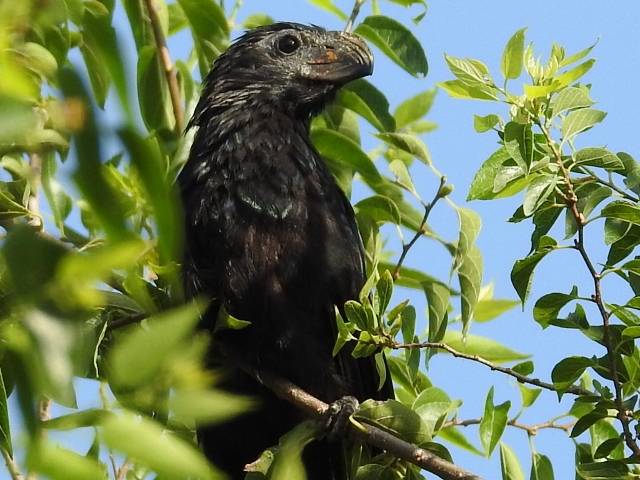by M. Kathy Raines

I mistook the black bird swaying atop the hackberry for a great-tailed grackle. I didn’t recognize its chirruping “TEE-ho”, but then grackles do possess a broad repertoire of whistles, clacks and shrieks. But, trying out a new camera that morning, I opted to take one final shot before escaping the sweltering August heat at Resaca de la Palma State Park.
Zooming in, however, I spotted a massive gray, parrotlike beak. I realized, with delight, I’d finally seen the peculiar-looking groove-billed ani (Crotophaga sulcirostris), a summer breeder in deep South Texas.
I’ve surely mistaken many anis for grackles. Midafternoon a couple weeks later, I returned and observed, in separate groves, two chatty groups perching amid foliage, its members fluttering off, then back. Numerous groove-billed anis have also nested at Sabal Palms Wildlife Sanctuary this year, as well as in other nearby refuges.
Some have called this unique, prehistoric-looking creature “grackle with a funny face” and “grackle body with a parrot bill,” said Kelly Cummins, Park Ranger and Interpreter at Resaca de la Palma. Cummins frequently observes anis at the park, especially from May through much of October, though she rarely sees them in June, right after their breeding displays. Cummins, like many, finds these anis, with their seemingly erratic movements, “funny, charming and inquisitive.”
Black with shimmers of purple and green, this jay-sized bird sports a long, droopy tail which appears haphazardly attached, swinging up and down and from side-to-side as if on a hinge. Flimsy-looking feathers often fluff up around its head, giving it an unkempt look. Its short wings flap, then extend for a glide, and its tail seems to fly over its head as it lands, giving it the appearance of instability. Weak fliers, anis struggle in strong gusts.
The ani’s large, decurved (downward pointing) bill is flat with evenly-spaced, but not readily apparent, grooves—of unknown function—on its upper mandible. Bare skin encircles its eyes. The ani is zygodactyl, having two toes pointing forward and two back, a distinguishing characteristic of its family, Cuculidae—making cuckoos and, surprisingly, roadrunners its cousins.
This ani’s grooved bill prompted its species name “sulcirostris” (“sulcus” meaning “grove” and “rostris”, beak). Its genus, “Crotophaga”, derives from Greek “kroton”, meaning “tick” and New Latin “phaga” for “eating”. Ticks are indeed on this bird’s varied menu. Tupi people, Brazilian aboriginals, called the bird “ani”. Only the smooth-billed ani (Crotophaga ani), which inhabits the swamplands of Florida and further south, shares this genus, and apparently, the two species do not intermix. A flock of anis may be called an “orphanage” or “silliness”.
Several anis forage together, eating seeds, fruit and other vegetation, insects and spiders. Anis may follow an ant swarm, then catch what eats the ants. An ani also sits, scanning its surroundings, then abruptly pounces upon a large grasshopper, capturing it with its sizeable bill and mashing it with its tip.
Anis may follow livestock, which, with their hooves, stir up edible arthropods. The birds may also alight on cattle, picking off ticks.
Though groove-billed anis breed in the Valley, they typically spend most of the year in dense thorn scrub and edges of woods near rivers and marshes in Mexico and Central or South America. “I primarily see them on the Island during fall migration as they move south,” said Javier Gonzalez, Naturalist Educator at South Padre Island Birding, Nature Center and Alligator Sanctuary. “Once in a while some will linger during the winter,” Gonzalez said, “but they are considered a bit uncommon to rare” during cooler seasons, when eager birders usually visit.
These anis make soft, gurgling sounds and two-syllable calls, often written as “tee-ho” or “pee-oh,” accented on the first syllable. When threatened, they raise strident cries of alarm, fluttering off frantically.
Anis, unless nestled too deeply in vegetation, sit well for photographs, and one does not have to rise early, even in mid-summer, to observe them sitting companionably together on branches.
During courtship, the male offers the female food. Depending upon circumstances, anis, like scrub jays, may congregate in several pairs—sometimes assisted by a young bird who has not yet mated—creating communal nests, into which up to four females deposit eggs. A nest may contain up to twenty eggs. Anis typically build their nests—bowl-shaped, leaf-lined bunches of twigs—in trees about eight feet high but may lay them in sugar cane. Males help gather materials, which females arrange.
When nesting communally, a dominant female may toss out the other females’ eggs until she lays hers; then they all sit on eggs simultaneously, the males generally sitting at night, the females, during the day. One female lays three or more eggs from which naked, black-skinned blind hatchlings emerge in from thirteen to fourteen days. In times of food scarcity, a pair may stop incubating eggs, allowing embryos to die after one or two young have hatched.
Fledglings leave the nest for short periods after about a week, flying a bit at 10 days, more successfully in about 17. Anis may raise two broods a year. An extensive Costa Rican study showed that, regardless of competition, multipair nesters fledge more young than do other birds in comparable habitats. Also, anis employing young helpers enjoy more success.
Groove-billed anis appear to be thriving, apparently unaffected by cowbirds, which parasitize many birds’ nests. Though anis occasionally wander into residential backyards during migration, they do not stray far from thorn scrub and forests with nearby water, areas made accessible to them in the Valley’s network of wildlife preserves.
